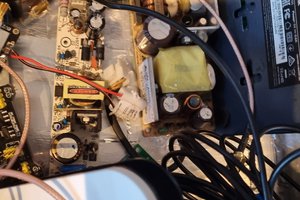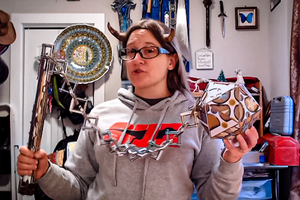Motivation
So I got a new audio receiver. It was from my local FreeCycle listserve. I use it to take the audio from my TV and power some outdoor speakers which come in handy for parties. But since I'm not employed right now, I didn't want to pay money for an FM antenna. so one night the stream of consciousness was something like:
Okay, so how hard can it be to make a dipole antenna?
What the hell is wrong with me? All these tutorials suck. No, I will not watch a YouTube video when a gif would do.
Shouldn't hyperphysics.com come up?
Fuck this, maybe I'll just buy one.
smile.amazon.com...
Good god are these ugly.
Fuck this.
Fuck dipoles.
FRACTALS!
wikipedia.com...
Wow, that article is short...oh, this is why I edit wikipedia.
Hmmm...invented 1995....
"fractal antenna patent"
Oh cool! First hit!
Ugh...this one is long...
Wife: Hey, what are you doing.
I was thinking about painting a fractal FM antenna on the entertainment cabinet.
No, you should paint it on canvas, and hang it on the wall.
<STARE>
What?! It's a good idea.
....No... Wood panel.
Yeah! With LEDs!
No.
[Giddy argument about the merits of a powered receiver antenna]
[Sleep]
Oh cool. This patent was filed 3 months after the 20 years from filing law was enacted. It's expired!
[Read patent]
Eureka! 86 by 69 cm! That fits on a wall!
Discussion of Patent
So Patent 6452553 is THE REASON that wireless phones after 2002 are rectangles, and wireless phones before 2002 are rectangles with a stick on one side. When I was in college in 2005?, I saw a talk by Benoit Mandelbrot where he said this was the reason, but I hadn't realized at the time that it was such recent history.
How to read a patent
Reading a patent is a difficult task for the uniniitated. I like to put the drawings in one pile, and the specification in another. Skim through drawings and see if you can figure out what the invention is from there. Then I scan the specification for the first place where the drawings are mentioned, usually, this will be in "BRIEF DESCRIPTION OF THE DRAWINGS", but sometimes, like in this patent, they mentn them in the "INTRODUCTION". I then start labeling the drawings with descriptions from the specs. This starts the process of figuring out what the drawings are, how they fit together, and what to expect when you read the specification.
The DETAILED DESRIPTION of a patent is written such that every numbered element in the drawings MUST be mentioned at least once, and usually written such that each numbered element that an element is conceptually connected to is mentioned. This writing style has the advantage that it creates a predictabilty for the reader if she only wants to read the section she cares about. It also has the advantage that the drawings can be published in a completely different section than the drawings. For all other purposes, it is terrible writing. It's highly redundant, difficult to understand, highly non-linear. And for all of the foregoing reasons, numerous typos go unnoticed.
The title is usually useless. The Abstract is usually just a jargon dump. The BACKGROUND is the attempt by the patent attorney to explain to her liberal arts father WTF is going on. It is usally useful, even for those who are familiar with the State of the Art. The Summary of the invention serves a purely legal purpose of providing written description to the claims, it is ignorable to anyone without a law degree. Algorithmically, you take the claims, remove the semicolons and claim numbers, add some periods, and paste them into that section.
Okay. So now that the dwaings and spec are seperated. The background is read, now you start DEEP READING. I read, and I start labeling the drawings. Usually, by the time you have put a name to each of the numbered elements in a drawing it becomes obvious what the invention is, and how it does it. If not, keep reading. If you get to the end, and don't understand the invention, congratulations, youare by definition, legally...
 Ari Diacou
Ari Diacou
 Daren Schwenke
Daren Schwenke
 neohackerjd
neohackerjd
 Ahron Wayne
Ahron Wayne
 Kal
Kal